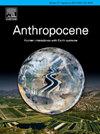Spatiotemporal evolution and attribution of urban exposure to compound precipitation and wind speed extremes in China since 1980
IF 3.9
2区 地球科学
Q2 ENVIRONMENTAL SCIENCES
引用次数: 0
Abstract
Frequent compound precipitation and wind speed extremes (CPW) increasingly threaten urban sustainability in China. This study comprehensively investigated the spatiotemporal evolution patterns and drivers of CPW in 355 cities in China from 1980 to 2018 based on China meteorological forcing dataset and China land cover dataset with inter-decadal trend analyses and exposure risk decomposition. The study revealed that from 1980 to 2018, 45 % of cities saw rising CPW frequency and intensity, while 60 % exhibited increased CPW risk. Notably, half of the cities with increasing trends showed sustained rises, primarily concentrated in northern and western China. Attribution analysis indicated that urbanization contributes to the increased risk of CPW while climate change and interactions are multidirectional. Specifically, the effect of climate change and interactions led to an increase in CPW risk in more than 40 % of cities, while urbanization led to an increase in CPW risk in more than 35 % of cities. However, the impacts of the drivers were spatially heterogeneous. Climate change and interactions dominate CPW contributions in northern, northwestern, North China, southwestern, and southern coastal areas of China, while urbanization dominates in the northeastern, eastern North China, eastern China, central China, and southeastern coastal areas.
1980年以来中国城市复合降水和极端风速暴露的时空演变与归因
频繁的复合降水和极端风速(CPW)日益威胁着中国城市的可持续性。基于中国气象强迫数据和中国土地覆盖数据,采用年代际趋势分析和暴露风险分解方法,对1980 - 2018年中国355个城市CPW的时空演变特征及其驱动因素进行了综合研究。研究显示,从1980年到2018年,45% %的城市CPW频率和强度上升,60% %的城市CPW风险增加。值得注意的是,有增长趋势的城市中有一半呈持续增长趋势,主要集中在中国的北部和西部。归因分析表明,城市化增加了CPW风险,而气候变化及其相互作用是多向的。具体而言,气候变化和相互作用的影响导致超过40% %的城市CPW风险增加,而城市化导致超过35% %的城市CPW风险增加。然而,驱动因素的影响具有空间异质性。气候变化和相互作用主导了华北、西北、华北、西南和华南沿海地区的CPW贡献,而城市化主导了东北、华北东部、华东、华中和东南沿海地区的CPW贡献。
本文章由计算机程序翻译,如有差异,请以英文原文为准。
求助全文
约1分钟内获得全文
求助全文
来源期刊

Anthropocene
Earth and Planetary Sciences-Earth and Planetary Sciences (miscellaneous)
CiteScore
6.30
自引率
0.00%
发文量
27
审稿时长
102 days
期刊介绍:
Anthropocene is an interdisciplinary journal that publishes peer-reviewed works addressing the nature, scale, and extent of interactions that people have with Earth processes and systems. The scope of the journal includes the significance of human activities in altering Earth’s landscapes, oceans, the atmosphere, cryosphere, and ecosystems over a range of time and space scales - from global phenomena over geologic eras to single isolated events - including the linkages, couplings, and feedbacks among physical, chemical, and biological components of Earth systems. The journal also addresses how such alterations can have profound effects on, and implications for, human society. As the scale and pace of human interactions with Earth systems have intensified in recent decades, understanding human-induced alterations in the past and present is critical to our ability to anticipate, mitigate, and adapt to changes in the future. The journal aims to provide a venue to focus research findings, discussions, and debates toward advancing predictive understanding of human interactions with Earth systems - one of the grand challenges of our time.
 求助内容:
求助内容: 应助结果提醒方式:
应助结果提醒方式:


